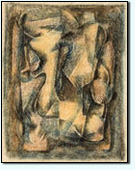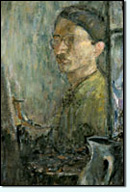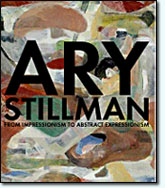Publications
Reminiscences > Ary's Marriage (1942-1941)
It was in 1941 — in September — that Ary phoned me and introduced himself. He had had dinner the evening before with Dr. Lande, of Sioux City, who was on his way to England to serve with the Red Cross. Dr. Lande, who had taken me to dinner the previous evening, had asked Ary if he knew me (I was from Sioux City too, was born there) and they evidently had talked about me at some length. What really prompted Ary to call me I don't know; it was so unlike him. He always said later that our angels in heaven had gotten together. In any event, in five months (February 26, 1942) we were married, at the home of my cousins, Louise Adams and her husband Milton.

Portrait of
the Artist's Wife
1943, oil on canvas, 36 x 23 in.,
[Ary Stillman Green Room,
University of Houston,
Moores School of Music, TX]
Ary's best man was a Russian friend whom he knew from Paris, an art dealer named Rabow. Rabow was a bachelor also, and neither Ary nor he knew anything about weddings, but Rabow vaguely recalled that it was customary to bring flowers to the bride. So the afternoon of the wedding they went to a florist shop. Rabow said he would buy the flowers. As they looked around they saw some very pretty flowering plants, and Rabow said it might be a good idea to bring a plant instead of flowers. Ary thought it would be a good idea, so that evening they arrived bearing a nice plant for the bride.
“I looked at it aghast, but remembered I was marrying an artist, and I mustn’t be surprised at anything he did.”
Ary was dressed in a dark suit, but underneath it he wore the pretty light blue sweater I had bought him for his birthday a couple of weeks before. I looked at it aghast, but remembered I was marrying an artist, and I mustn’t be surprised at anything he did. And during the wedding supper when Ary became too warm in the blue sweater I helped him take it off.
I have never seen anyone as nervous looking as Ary when he came in to the apartment, where a few of the family were gathered. His face was ashen and he was shaking like a leaf. I was frightened and terribly sorry for him, and I drew him aside and said: "Ary, it isn't too late to back out, if you don't want to go through with it." But he said no, he wanted to have the wedding.
“Ary had warned me that his painting would have to come first, that I would have to take second place to it.”
I knew that Ary hadn't married as a young man because he wanted to be free to paint. He knew that if he had the responsibility of a wife, and probably children, he couldn't be absolutely free — he would have to compromise with his ideals. In fact, Ary had warned me that his painting would have to come first, that I would have to take second place to it. It was so at first, I believe. But gradually I assumed more and more importance to him, and his painting and I seemed to merge into one. The second summer after we were married I received a letter from Ary from Rockport, Massachusetts where he had gone to get settled in a vacation spot (I was to join him later). He wrote:
"It was hard at work today and while painting I kept thinking about you. Strange, how a person who lived to himself for so many years should change to such a degree. I never imagined that I was capable of loving the way I do. Undoubtedly it was always within me and you during these 16 months have brought it out — it was you who were capable of performing that change. My life is fuller, while before I just painted, now I paint for my dear Frances, and feel doubly happy."
This feeling grew ever stronger with time, and in the later years when Ary would show a new painting to someone he would often say 'We painted this —" and I would have to correct him "No, I cooked the dinner. You painted."
As the years had gone on, Ary and I had become more and more dependent upon one another. After I gave up working in 1957, we were together constantly, really 24 hours a day. We realized that it was not wise, this utter dependency, and more than once we gave voice to the thought that one or the other of us would eventually pay dearly for this, in the unbearable pain of loss and aloneness. But I would say, "Ary, it is so precious, so wonderful while it lasts that I don't think we should deny ourselves the joy of it. It is such a miraculous experience — one that comes to so few — it is worth paying the price for." And now that almost two years have passed since Ary's death, I still feel I was right, in spite of having now to live in a world where each day is painful to approach. I don't believe that anyone ever loved and admired anyone more than I loved and admired Ary. To the end there was a fascination about his every word, his every movement, his smile. And such admiration of his honesty, his modesty, his refinement, his sensitiveness, his beauty of spirit, his tenderness, and of course his great talent.
I am tremendously grateful to those of my family and Ary's family who are so kind and affectionate and attentive; without them I could not go on. But my one reason for living is to try to do something for Ary's paintings. They are my joy and at the same time my agony, for they are here and Ary himself is not. But definitely they are my raison d'etre. I find myself again and again thanking Ary for having made life worthwhile for me. And I promise him again and again that I will never cease my efforts to do what I can to help his paintings live on and to attain the recognition they deserve, which was, like with so many other artists, denied him during his lifetime.
As I reread the above, I think of a sentence that struck me in Thornton Wilder's "The Eighth Day" and which I copied down:
"The fairest gifts — and the most baneful — are those of which the donor is unconscious, they are conveyed over the years in the innumerable occasions of the daily life — in glance, pause, jest, silence, smile, expressions of admiration or disapproval."
Copyright © 2002-2007 The Stillman-Lack Foundation.
All text and images on this site may not be published, broadcast, or distributed in any form without the prior written permission of The Stillman-Lack Foundation.




